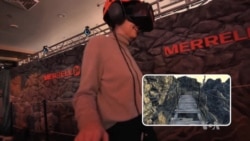Advertising is practically inescapable these days, pervading our daily lives, mobile devices and now even virtual reality.
With the growing number of virtual reality headsets and apps coming to market, opportunities to experience VR are more readily available, but so too is the potential to experience more advertising. Brands like Oreo, Mountain Dew, Jim Beam, Lufthansa and Marriott have already jumped on the virtual reality bandwagon, creating one-off experiences to engage consumers. For these companies, whether the reality is physical or computer-generated is less important than capturing your attention.
“Augmented reality and virtual reality are expected to hit $150 billion in revenue by 2020... that number is going to catch the eye of marketers,” said Katie Richards, staff writer at Adweek.
For brands, that means creating experiences that work alongside their own products, like last year’s collaboration between outerwear company Merrell and creative studio Framestore, to create a virtual reality mountain hike for the launch of Merrell’s Capra hiking boots. Viewers were given the chance to virtually traverse the Dolomite Mountains of Italy.
“It really puts you in the space of what it’s like to wear the shoes and be in one of these really crazy environments,” noted Richards.
German airline Lufthansa also took viewers to new heights with its VR app, immersing them in a first-class business cabin, complete with flight attendants and champagne service. The experience was created in collaboration with 3spin, a design and technology company specializing in 360-degree virtual reality filmmaking.
German airline Lufthansa partnered with 3spin to create an in-cabin virtual reality experience Credit: 3spin
“Up until now, the most powerful medium on the planet or most immersive medium was a giant screen cinema or IMAX type of theater. Virtual reality’s more immersive than that,” said NextVR co-founder DJ Roller. NextVR partners with brands like Fox Sports to transform live events into virtual reality.
“For an advertiser to be able to connect with their audiences in VR is a very powerful, and in some ways emotional sometimes, response you get,” Roller added.
With a captive audience built in, Roller sees advertising as a natural extension of the technology, “We’re able to erase and replace things very easily.”
That means a virtual reality viewer in Asia could see a more relevant ad during a Coldplay concert (one of the live events NextVR streamed in VR) than say, a U.S. viewer.
While it’s not clear how effective these VR campaigns are, one thing is for sure: they still cost money.
“It is quite expensive for the marketer and for the agency to create this experience,” noted Richards. “The other challenge is making sure that what you’re doing stays true to your brand, and you’re not just experimenting with virtual reality to do it,” she added.
But for the digital natives that make up today’s youth, virtual reality might be as normal as chicken McNuggets. In Sweden, participating McDonald’s restaurants have begun serving Happy Meals in boxes that convert to basic virtual reality viewers.
McDonald’s locations in Sweden are testing Happy Meal boxes that transform into virtual reality viewers. Credit: McDonald’s Sverige
For digitally-savvy brands, virtual reality is one more way to reach the highly-coveted millennial demographic.
“Millennials are willing to spend a lot of money on experiences,” said Richards, “Virtual reality is a way for a marketer to give a millennial an experience that they might not have otherwise.”
An out-of-this-world experience that marketers hope will result in real world spending.







